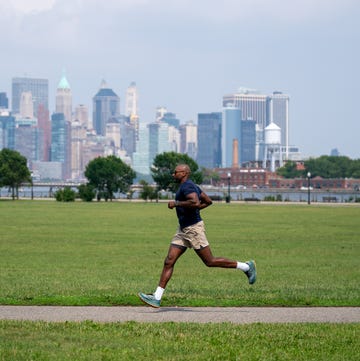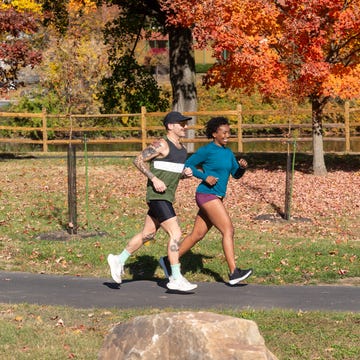The start of any new season provides the perfect opportunity to set new goals or complete a few old ones. It provides some motivation to finally start a regular run routine or tackle training for your first or next marathon.
The spring season, specifically, can provide some of the most ideal running days, which makes getting out the door more enjoyable. But as the saying goes, April showers bring May flowers, so you can’t expect great weather all the time. This is what makes running in the spring so tricky.
To help you navigate the highs and lows of springtime, we tapped a few run coaches for their best tips on spring running. Here’s how they suggest you manage your schedule, tackle your runs, and more.
1. Clean Out Your Running Closet and Nutrition Cabinet
Your spring cleaning checklist should include cleaning out and reorganizing all of your running gear and nutrition products so you’re ready to go out and clock miles. Look for any running items that are tattered or worn, says Rachel Laymon, UESCA-certified run coach and owner of Run Well Be Well, based in Akron, Ohio.
This way, you can identify which items you need to replace, like worn out running shoes or sports bras that have celebrated many birthdays. She also recommends taking this opportunity to sift through all of your nutrition products for expired gels, chews, salt tablets, and more. If you have your sights on a long-distance race, you’ll definitely want to restock.
2. Make Sure You Have the Right Gear
We often prepare for drastic weather changes in winter and summer months but neglect to prepare for the change of weather any other time of year. The spring weather can be nearly as unpredictable, so keep certain items on hand, such as a rain jacket, gloves, and a mix of shorts and leggings. The right gear can help you feel more comfortable, Laymon says, and therefore run more consistently.
A headlight, LED vest, or a reflective vest is also smart to have in your closer, as this gear can make you more visible to others when running in the dark, says Laymon. She also recommends fleece-lined and water-resistant leggings, gloves, and neck gaiters. These items can come in handy for early morning or late evening runners in particular.
Laura Filla, level 2 RRCA-certified running coach, certified personal trainer, and the owner of Filla Endurance recommends having layers. For example, wearing shorts, a sports bra, a tank top, long sleeves, gloves, and a jacket or hoodie.
“This way, you know you’re warm enough but also have the flexibility to remove layers if you get too warm. If possible, plan a route that allows you to circle back to your car [or house], so you can shed the layers as needed,” Filla says.
Our what to wear tool can help you find the perfect outfit for any given run depending on your local weather conditions, type of workout, and a few other key details.
3. Avoid Pushing Your Intensity Too Soon
Don’t get so excited by the warm temperatures that you rush into high-intensity workouts if you’re just starting out, or haven’t been running as much recently. “It’s easy to head to the track for hard speedwork sessions without properly preparing for the new intensity,” says Randy Accetta, director of education for the Road Runners Club of America.
If you’re following a training plan, stick to what’s on the schedule. If you’re not following a plan but want to up your speed, Accetta recommends you practice either 100-meter strides or gentle hill sprints two to three times a week for three weeks—before getting into anything longer or more intense. This will get you more prepared for demanding workouts, he says.
4. Wear Sunscreen
“Even if it’s not a super sunny day, the UV rays are out and we’re still at risk for sunburn,” says Gab Reznik, NASM-certified personal trainer and nutrition coach, marathoner, and Tone House head coach. She recommends finding a sunscreen that is sweat proof and lightweight like those from Supergoop! or La Rouche-Posay.
5. Find a Friend
Getting started with running can feel tough. Laymon recommends joining a run group or simply running with a friend. Running with a partner holds you more accountable to your run goals (and individual workouts), and it can also encourage you to explore new places this spring, she says.
6. Hydrate Appropriately
Though meeting hydration needs is important for runners all year round, “hydration becomes even more important as we transition into spring and the climate begins to change,” says Reznik.
When the temperature rises, you’re likely to sweat more, especially if you’re running in humid conditions. This can increase your risk of dehydration, she explains. It’s also why you want to make sure you’re drinking enough water throughout the day and replenishing electrolytes (sodium, potassium, and magnesium) lost in sweat. Most foods can help you with this, but you can also get electrolytes from sports-specific products like powders, drinks, tablets, and more, Reznik adds.
7. Give Your Body Time to Adjust to the Heat
You’ve probably heard that your body needs time to adjust to temperature changes in the summer and winter months—the same is true for running during the spring months.
“In the early days of higher temperatures you may run a bit slower, feel more tired, and have a higher heart rate than normal,” says Accetta. This is your body’s way of adjusting to running in warmer temperatures, so don’t be alarmed. Within a couple of weeks, your body will acclimate and you’ll get used to running at your normal speeds again, he says.
8. Make time for Recovery
It’s completely fine to take advantage of the nice weather spring has to offer by moving an indoor workout outdoors, or swapping a strength day with a run. Doing so will benefit you both physically and mentally, says Laymon. “Flexibility is the name of the game,” she says.
Just avoid stacking hard workouts (tempo runs, speed workouts, long runs) back to back so you can give your body enough time to recover.
Also, pay attention to the time in-between workouts to allow for adequate recovery, says Filla. For example, if you’re running in the morning and strength training in the evening, give yourself six hours between.
9. Map Out Your Run Goals
Take this time to define or reevaluate your run goals. There’s a lot you can do to prepare for a race before jumping into a training plan and you can use the nice spring weather as motivation to get started, says Filla.
For example, if the weather motivates you to sign up for a race, then you should identify what distance you want to conquer, define how many weeks you have to train for the distance, and select a training plan to help you achieve this goal, all before you actually get out the door and start running.
You also want to experiment with different fueling strategies, fine tune your sleep schedule, and make time for cross-training, so you can show up to race day as your best self.
10. Embrace the Rain
Those showers may bring flowers, but they don’t make showing up to outdoor workouts easier. But rather than skipping a workout, get out there. Remember: Consistency will help you become a better runner.
Des Linden said it best when she reminded us to take things one day at a time and to keep showing up, says Laymon. Come race day, you’ll thank yourself for showing up on all those cruddy days, she adds.

Monique LeBrun is a health and fitness editor who is based in Easton, Pennsylvania. She covers a wide range of health and wellness topics, with a primary focus on running performance and nutrition. Monique is passionate about creating content that empowers runners to become the best versions of themselves. As an avid runner and parent, she loves spending time outdoors with her daughter, who often accompanies her on weekend runs as her personal mini run coach.













